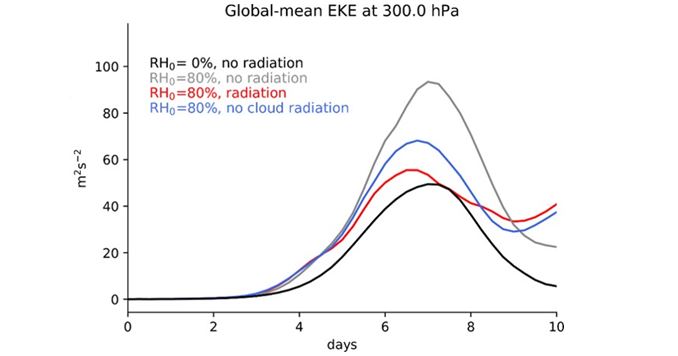Weakening of extratropical cyclones by cloud-radiative interactions
The weather of the midlatitudes is determined by low-pressure systems, or cyclones, that travel along the jet stream from west to east. How the jet stream and the cyclones will respond to global warming is an important topic in climate research, as this will shape the regional manifestations of a globally changing climate. The young investigator group of Dr. Aiko Voigt to addresses this question, in particular studying the role of clouds and their interactions with radiation.
In a recently published article in the international journal Geophysical Research Letter, Sophia Schäfer and Aiko Voigt showed for the first time that the heating and cooling of the atmosphere by radiation indeed has a strong impact on idealized cyclones. To this end, the two researchers conducted numerical simulations with the atmosphere model ICON on an aquaplanet, i.e., a planet that is only covered by water. They investigated how the presence, or absence, of radiation affects the lifecycle and strength of idealized cyclones. They also varied the moisture content of the atmosphere. This allowed them to compare the radiative impact with the impact of latent heating. Latent heating occurs when water vapor condenses, and since long is known to be an important factor for cyclones.
| Temporal evolution of the strength of idealized cyclones in simulations with the ICON atmosphere model. The strength is measured by the eddy kinetic energy (EKE) in the upper troposphere at 300 hPa. The cyclones reach their peak strength at around day 7 after the simulations are started. RH0 indicate the relative humidity of the atmosphere at the start of the simulations. A dry atmosphere without latent heating is indicated by RH0=0%, a moist atmosphere by RH0=80%. |
In the simulations the cyclones develop over a period of several days. Their strength is measured in terms of the eddy kinetic energy in the upper troposphere. The figure shows the resulting cyclones depending on the treatment of radiation and latent heating. Latent heating leads to a clear intensification of the cyclone (grey versus black line), consistent with previous work. Importantly, however, radiation leads to a strong weakening of the cyclone (red versus grey line). A substantial part of the radiative weakening can be attributed to clouds (blue versus red line), as is shown by a simulation in which clouds are made transparent to radiation.The two researchers believe that the clouds in the so-called warm conveyor belt region of the cyclone play a particular role. In this region, large-scale ascent leads to clouds that extent vertically over many kilometers from the boundary layer to the tropopause.
In the future, Aiko Voigt and his group plan to build upon these idealized simulations to understand the radiative impact on cyclones that have actually occurred over the last years. In particular, their work will include an analysis of the observations obtained from the airplane-based measurement campaign NAWDEX that was conducted over the region of the North Atlantic in fall 2016.
Reference: Schäfer, S. A. K. and A. Voigt (2018), Radiation weakens idealized midlatitude cyclones, Geophysical Research Letters, 43, 2833-2841.
[Working group: Clouds and storm tracks]

